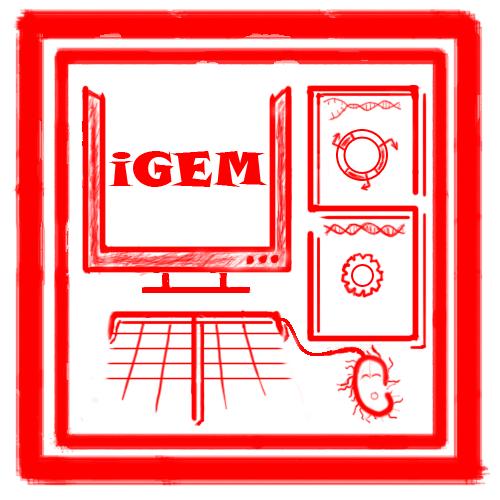Team:USTC Software/What
From 2009.igem.org
(New page: =Example 1. Synthetic Oscillator= ==Introduction== The synthetic oscillatory network designed by Elowitz and Leibler is ........... ==Mathematical Formulation== The activities of a gen...) |
|||
| Line 1: | Line 1: | ||
| + | __NOTOC__ | ||
| + | {{USTCSW_Heading}} | ||
| + | |||
| + | {|- | ||
| + | |||
| + | |{{USTCSW_SideBarL}} | ||
| + | |||
| + | | | ||
=Example 1. Synthetic Oscillator= | =Example 1. Synthetic Oscillator= | ||
| Line 79: | Line 87: | ||
[[Image:]] | [[Image:]] | ||
| + | |||
| + | |||
| + | |||
| + | |||
| + | | | ||
| + | {{USTCSW_SideBarR}} | ||
| + | |} | ||
| + | |||
| + | {{USTCSW_Foot}} | ||
Revision as of 04:00, 19 October 2009
| About | Team and People | Project | Standard | Notebook | Demo | Safety | External Links |
|---|
|
|
Example 1. Synthetic OscillatorIntroductionThe synthetic oscillatory network designed by Elowitz and Leibler is ........... Mathematical FormulationThe activities of a gene are regulated by other genes through the interactions between them, i.e., the transcription and translation factors. Here, we assume that this system follows Hill kinetic law. <math>\begin{align} \frac{dm_{i}}{dt} &=-a_{i}m_{i}+\sum\limits_{j}b_{ij}\frac{p_{j}^{H_{ij}}}{K_{ij}+p_{j}^{H_{ij}}}+l_{i}, \\ \frac{dp_{i}}{dt} &=-c_{i}p_{i}+d_{i}m_{i}, (i=1,2,...,n) \end{align}\,\!</math> where <math>m_{i}(t), p_{i}(t)\in {\mathbb{R}}</math> are concentrations of mRNA and protein of the <math>i</math>th node at time <math>t</math>, respectively, <math>a_{i}</math> and <math>c_{i}</math> are the degradation rates of the mRNA and protein, <math>d_{i}</math> is the translation rate. Term (1) describes the transcription process and term (2) describes the translation process. Negative and positive signs of <math>b_{ij}</math> indicates the mutual interaction relationship that could be attributed to negative or positive feedback. The values describe the strength of promoters which is tunable by inserting different promoters in gene circuits. <math>H_{ij}</math> is Hill coefficient describing cooperativity. <math>K_{ij}</math> is the apparent dissociation constant derived from the law of mass action (equilibrium constant for dissociation). We can write <math>K_{ij}=\left( \hat{K}_{ij}\right) ^{n}</math> where <math>\hat{K}</math> is ligand concentration producing half occupation (ligand concentration occupying half of the binding sites), that is also the microscopic dissociation constant. A Tunable OscillatorThe original three repressors model is described as follows:% <math>\begin{align} \frac{dm_{1}}{dt} &=-am_{1}+b\frac{p_{3}^{H_{13}}}{K+p_{3}^{H_{1}}}, \\ \frac{dm_{2}}{dt} &=-am_{2}+b\frac{p_{1}^{H_{21}}}{K+p_{1}^{H_{2}}}, \\ \frac{dm_{3}}{dt} &=-am_{3}+b\frac{p_{2}^{H_{32}}}{K+p_{2}^{H_{32}}}, \\ \frac{dp_{1}}{dt} &=-cp_{1}+dm_{1}, \\ \frac{dp_{2}}{dt} &=-cp_{2}+dm_{2}, \\ \frac{dp_{3}}{dt} &=-cp_{3}+dm_{3},\text{ } \end{align}\,\!</math> where <math>a, b,</math> <math>c,</math> <math>d,</math> <math>H_{1},</math> <math>H_{2},</math> <math>H_{3},</math> <math>K</math> are tunable parameters that could change wave amplitude and frequency. For simplicity, we assume that <math>H_{13}=H_{21}=H_{32}=2,</math> meaning that the system contains only positively cooperative reaction that once one ligand molecule is bound to the enzyme, its affinity for other ligand molecules increases. <math>\begin{align} figure\text{ 1}\text{: wave amplitude} && \\ figure\text{ 2}\text{: wave frequency} && \\ figure\text{ 3}\text{: sensitivity analysis} && \end{align}\,\!</math> [[Image:]] An Alternative Topology That Leads to OscillationThe original three repressors model is described as follows:% <math>\begin{align} \frac{dm_{1}}{dt} &= -a_{1}x_{1}+\frac{b_{1}}{K_{1}+p_{2}^{H_{12}}}, \\ \frac{dm_{2}}{dt} &= -a_{2}x_{2}+\frac{b_{2}p_{3}^{H_{23}}}{% K_{2}+p_{1}^{H_{21}}+p_{3}^{H_{23}}}, \\ \frac{dm_{3}}{dt} &= -a_{3}x_{3}+\frac{b_{3}}{K_{3}+p_{2}^{H_{32}}} \\ \frac{dp_{1}}{dt} &= -c_{1}p_{1}+d_{1}m_{1}, \\ \frac{dp_{2}}{dt} &= -c_{2}p_{2}+d_{2}m_{2}, \\ \frac{dp_{3}}{dt} &= -c_{3}p_{3}+d_{3}m_{3}, \end{align}\,\!</math> [[Image:]]
|
|
 "
"




























